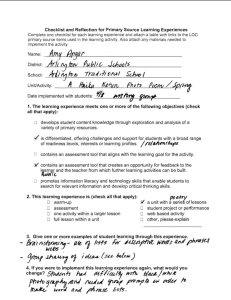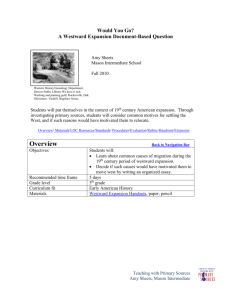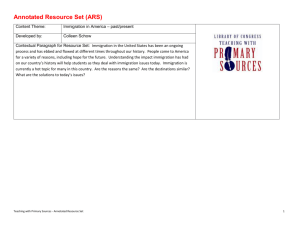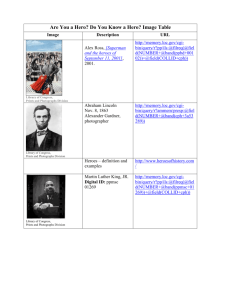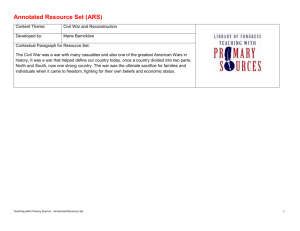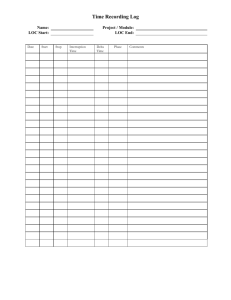Replace This Text With The Title Of Your Learning Experience
advertisement
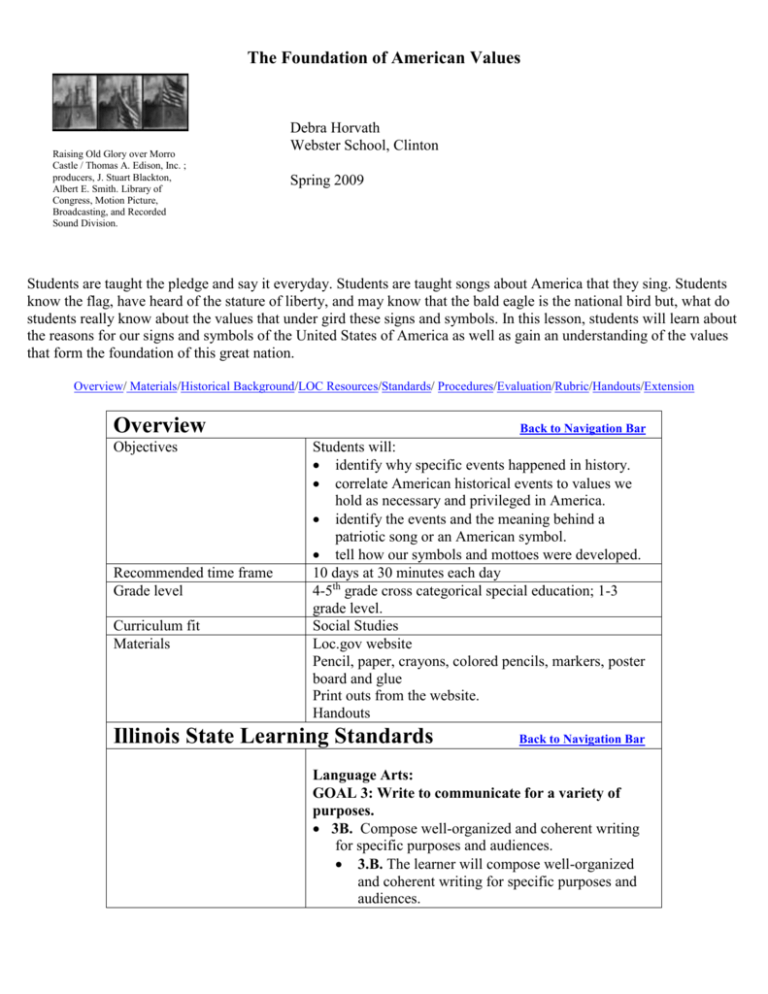
The Foundation of American Values Raising Old Glory over Morro Castle / Thomas A. Edison, Inc. ; producers, J. Stuart Blackton, Albert E. Smith. Library of Congress, Motion Picture, Broadcasting, and Recorded Sound Division. Debra Horvath Webster School, Clinton Spring 2009 Students are taught the pledge and say it everyday. Students are taught songs about America that they sing. Students know the flag, have heard of the stature of liberty, and may know that the bald eagle is the national bird but, what do students really know about the values that under gird these signs and symbols. In this lesson, students will learn about the reasons for our signs and symbols of the United States of America as well as gain an understanding of the values that form the foundation of this great nation. Overview/ Materials/Historical Background/LOC Resources/Standards/ Procedures/Evaluation/Rubric/Handouts/Extension Overview Objectives Recommended time frame Grade level Curriculum fit Materials Back to Navigation Bar Students will: identify why specific events happened in history. correlate American historical events to values we hold as necessary and privileged in America. identify the events and the meaning behind a patriotic song or an American symbol. tell how our symbols and mottoes were developed. 10 days at 30 minutes each day 4-5th grade cross categorical special education; 1-3 grade level. Social Studies Loc.gov website Pencil, paper, crayons, colored pencils, markers, poster board and glue Print outs from the website. Handouts Illinois State Learning Standards Back to Navigation Bar Language Arts: GOAL 3: Write to communicate for a variety of purposes. 3B. Compose well-organized and coherent writing for specific purposes and audiences. 3.B. The learner will compose well-organized and coherent writing for specific purposes and audiences. Social Sciences: Goal 14F: Can understand the development of United States political ideas and traditions. 3F. Understand the development of United States political ideas and traditions. 1.F. Describe values that have formed the foundation of the American democratic system 2.F. Summarize the meaning of the words, sounds, or images in an artistic expression that illustrates the traditions important to our political system and concept of freedom. 3.F. Explain the significance of political symbols, and mottoes, of the United States Procedures Back to Navigation Bar In this lesson, students will define the meaning of values, review a brief history of America to determine the values on which America was founded, investigate primary resources available to further develop an understanding of the values and write about the symbols, mottoes and songs. Day One: Discussion starter: What do you look for in a friend? Discuss the character traits that each person identifies. Discuss the meaning of the word “values”. Define values. What values do you believe the United States of America was founded upon? Give students Handout #1 to write down the values they want in a friend and the values they believe that the United States was founded upon. HOMEWORK: Ask your parents, grandparents or aunts and uncles what values they believe are important in a friendship. Ask your parents, grandparents or aunts and uncles what values they believe are important in the United States. Day Two, Three, and Four Ask students to identify the values that their parents believe are important in a friendship. Ask students to identify the values that their parents believe are important for our country. Compile the list for future reference. Begin or review the historical background of the United States of America. Go to http://www.americaslibrary.gov/cgibin/page.cgi/jb Begin by asking the students about the picture in each time period. What does the picture tell you about this time period? Read the history. Following each time period ask students to identify the values that we wanted or learned at that time. Colonial America (1492-1763) Revolutionary Period (1764-1789) The New Nation (1790-1828) Western Expansion & Reform (1829-1859) Civil War (1860-1865) Reconstruction (1866-1877) Gilded Age (1878-1889) Progressive Era (1890-1913) Great War & Jazz Age (1914-1928) Depression & WWII (1929-1945) Modern Era (1946 - present) After reviewing the time eras, discuss the values. Identify the ones that were similar and the ones that were different. Help students list the most important values such as: freedom, acceptance, gratitude, justice, loyalty, citizenship, forgiveness, love of learning, kindness or sharing, trustworthiness, honesty, truthfulness, and fairness. Day Five, Six and Seven Put the chart with all the value words up on the board. Ask students to pick one value word that they would like to research. Ask students to research their word within the http://www.loc.gov/index.html website as well as through www.google.com or encyclopedias and other resource books. Other sections of the http://www.loc.gov/index.html website include http://www.loc.gov/exhibits/treasures/; Black history: http://memory.loc.gov/ammem/aaohtml/exhibit/ aointro.html; Women’s history http://memory.loc.gov/ammem/awhhtml/index.h tml; American Memory section http://memory.loc.gov/ammem/index.html. Explain the project. Students will research the word chosen. After saving the pictures, stories, poems, songs, recordings, ask them to make a poster of their word and what it means. Show them an example. Show students how to save pictures and resources from the website for easy retrieval and printing. After researching the value word, ask them to print out their pictures, prints, maps, songs, etc. and develop their poster. They will need to complete this at home. Day Eight and Nine Write the following list on the board: US Flag, US Seal, Presidential Seal, National Bird, Washington Monument, Lincoln Memorial, White House, Liberty Bell, Statue of Liberty, National Anthem- Star Spangled Banner, Pledge of Allegiance. Go to http://enchantedlearning.com/history/us/symbols / Give out the booklets on the American Symbols Discuss each symbol and how it came to be Discuss the values that it represents. Write the value of each motto and symbol in the booklet. Day Ten History Fair, students put on a History Fair for the rest of the school. Show the DVD or PowerPoint, skits, posters, poems and art work. Evaluation Back to Navigation Bar Students will be graded on their poster project and their final presentation. Extra credit will be given for the extension projects. Extension Back to Navigation Bar Write a poem about the value word. Draw a picture that accurately represents what that means for us in our lives in the twenty-first century. If you do a haiku poem, water paint a picture to reflect the poems message. Develop a power point or a DVD of all the values that were studied. Develop a skit(s) about the values studied. Video tape the skit to show the class and/or other classes. Historical Background Back to Navigation Bar Websites to access further information about the historical events that are the foundation of our democracy. Brief Timeline of American Literature and Events: http://www.wsu.edu/~campbelld/amlit/1651.htm American History: http://americanhistory.about.com/ History of the United States: http://en.wikipedia.org/wiki/American_history American History: http://www.historycentral.com/USHistory.html The History Place: http://www.historyplace.com/ Kids Learn Out Loud: http://kids.learnoutloud.com/Kids-Free-Stuff/History/American-History Apples for the Teacher: http://www.apples4theteacher.com/coloring-pages/american-history/ Other Resources: Liberty Kids DVD: Liberty's Kids® ©2004 DIC Entertainment. Tell Me Why: Americana /Beginnings, The Children’s DVD Encyclopedia, DSSP Inc., 2003 Primary Resources from the Library of Congress Back to Navigation Bar RESOURCE TABLE SAMPLE RESOURCES for the POSTER PROJECT Image Freedom Freedom on the old Description From The Phonoscope, January 1899, p. 15: Down goes the Spanish flag, and up floats the Stars and Stripes. Down falls the symbol of tyranny and oppression that has ruled in the new world for four hundred years, and up goes the Banner of Freedom. In the distance are the turrets and battlements of Morro, the last foothold of Spain in America. (C. Musser, Edison motion pictures 1890-1900, According to Edison film historian C. Musser, the film was made by Vitagraph producers and Edison licensees J. Stuart Blackton and Albert E. Smith, then submitted as a negative to Edison’s Kinetograph Dept., which copyrighted and distributed the title. (Edison motion pictures 1890-1900, p. 481-482) Citation Library of Congress, Motion Picture, Broadcasting, and Recorded Sound Division. URL http://memory.loc. gov/cgibin/query/r?amme m/papr:@field(NU MBER+@band(sa wmp+1032)) Freedom, freedom, freedom on the old plantation Historic American Sheet Music, "Freedom on the Old Plantation", Music B451, Duke University Rare Book, Manuscript, and Special Collections Library http://memory.loc. gov/cgibin/query/r?amme m/dukesm:@field( DOCID+@lit(ncd hasm.b0451)) plantation. 1866 The Africans of the slave bark “Wildfire” Freedom The beginning of the 19th century was, for many Americans, a time to take stock. The writer of this poem is unknown, and he chose to identify himself only as a Revolutionary soldier drawing closer to his death. As you read the poem, think about the achievements this writer describes, as well as which responsibilities he feels he is leaving for future The writer of this poem is unknown, and he chose to identify himself only as a Revolutionary soldier drawing closer to his death. Library of Congress, Rare Book and Special Collections Division, America Singing: NineteenthCentury Song Sheets. http://memory.loc. gov/cgibin/ampage?collId =amss&fileName= as1/as107890/ams spage.db&recNum =0 The Africans of the slave bark "Wildfire"-The slave deck of the bark "Wildfire," brought into Key West on April 30, 1860 Illus. in: Harper's weekly, 1860 June 2, p. 344.; Library of Congress Prints and Photographs Division Washington, D.C. 20540 USA http://lcweb2.loc.g ov/cgibin/query/i?pp/ils: @field(NUMBER +@band(cph+3a4 2003)) Friday, August 29th, 2008 Carol Highsmith sent some images from yesterday’s final day of convention festivities in Denver: Copyright free http://www.loc.go v/extranet/paodocs /images/dnc2008/b arack-obama.jpg African men crowded onto a lower deck; African women crowded on an upper deck. President-Elect Barak Obama final day of convention festivities in Denver. President Barak Obama, First Black President, 2009 photos, Library of Congress Mrs. Rosa Parks Woman fingerprinted. Mrs. Rosa Parks, Negro seamstress, whose refusal to move to the back of a bus touched off the bus boycott in Montgomery, Ala. Mrs. Rosa Parks being fingerprinted by Deputy Sheriff D.H. Lackey in Montgomery, Alabama. Two women holding a banner between them reading "National Woman Suffrage Association." Library of Congress, Prints & Photographs Division, NYWT&S Collection, [reproduction number, LC-USZ62109643 (b&w film copy neg.)] http://memory.loc. gov/cgibin/query/r?pp/ils: @filreq(@field(N UMBER+@band( cph+3c09643))+@ field(COLLID+cp h)) Library of Congress, Prints and Photographs Division [reproduction number, LC-USZ6293552 DLC (b&w film copy neg.)] http://memory.loc. gov/cgibin/query/r?amme m/suffrg:@field(N UMBER+@band( cph+3b39728)) Reynolds's political map of the United States, designed to exhibit the comparative area of the free and slave states and the territory open to slavery or freedom by the repeal of the Missouri Compromise. Library of Congress, Geography and Map Division. http://memory.loc. gov/cgibin/query/r?amme m/gmd:@filreq(@ field(NUMBER+ @band(g3701e+ct 000604))+@field( COLLID+setlmap) ) Library of Congress, Prints and Photographs Division [reproduction number, LC-USZ6216225 DLC (b&w film copy neg.)] http://memory.loc. gov/cgibin/query/r?pp/ils: @filreq(@field(N UMBER+@band( cph+3a18453))+@ field(COLLID+cp h)) Suffragists Mrs. Stanley McCormick and Mrs. Charles Parker, April 22, 1913 Free and Slave States Abraham Lincoln A. Lincoln showing Sojourner Truth the Bible presented by colored people of Baltimore, Executive Mansion, Washington, D.C., Oct. 29, 1864; The 13th with Sojourner Truth First and the Last Portrait of Dr. W.E.B. Amendment to the Constitution: Civil Rights Act of 1866 The Civil Rights Act of 1866 guaranteed African Americans basic economic rights to contract, sue, and own property. Significance: The intention of this law was to protect all persons in the United States, including African Americans, in their civil rights. Hiram Revels of Mississippi was elected the country's first African-American senator in 1870. 04/1901; African Methodist Episcopal Church Review, Vol. 17, Num. 4; The Ohio Historical Society is offering public access to these materials for educational and research purposes only. Most of the published materials digitized for this electronic collection date from before 1923 and are presumed by the Ohio Historical Society to be in the public domain. First leader of the newly formed National Association for the Advancement of Colored People, 1910. Developed as a result of two black men in Springfield, IL being lynched. Manly, Alex, L., First and the Last, 04/1901, National Afr0-American Museum and Cultural Center, The AfricanAmerican Experience in Ohio, 1850-1920, Library of Congress. http://memory.loc. gov/cgibin/query/r?amme m/aaeo:@field(DO CID+@lit(o2257)) Library of Congress, Prints & Photographs Division, Carl Van Vechten collection, [reproduction number, LC-USZ6242528 DLC (b&w film copy neg.)] http://memory.loc. gov/cgibin/query/r?amme m/van:@field(NU MBER+@band(cp h+3a42846)) Du Bois Rubric Back to Navigation Bar POSTER RUBRIC: AMERICAN VALUES The poster and presentation of American values and history will be graded on the following scale. Category Graphics 4 All graphics are relevant to the value. 3 Most graphics are relevant to the value. Labels All labels are clear, neat and accurate. Understanding Student understands the value and can clearly and concisely discuss the poster. All labels are accurate and somewhat neat. Student understands the value and can reasonably discuss the poster. 2 The majority of graphics are relevant to the topic. All labels are somewhat neat and mostly accurate. Student understands the value but has difficulty presenting the poster. Attractiveness The layout, design and neatness are outstanding. Mechanics Capitalization and punctuation are accurate. Grammar is correct. The layout, design and neatness are somewhat exceptional. Capitalization and punctuation are 90% accurate. Grammar is 90% accurate. The layout, design and neatness are somewhat confusing. Capitalization and punctuation are 80% accurate. Grammar is 80% accurate. Grammar 1 Half of the graphics are relevant to the topic. All labels are mostly accurate but messy or difficult to read. Student has some understanding of the value and is able to present the poster with some clarity. The layout, design, and neatness are messy and difficult to understand. Capitalization and punctuation are 70% accurate. Grammar is 70% accurate. Handouts Back to Navigation Bar K What do you already know about the values American was founded upon? W L What do you want to know about the values America was founded upon? What have you learned about the values America was founded upon? Name ____________________________________ Date _________________________ VALUES My Values in a Friend My Values in the United States Parents’ or Family Values Values in a Friend Values in America

